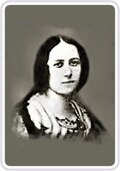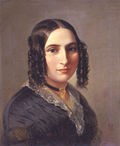List of 999 women on the Heritage Floor / Ethel Smyth
This list describes the place setting for Ethel Smyth on the table of Judy Chicago's art installation The Dinner Party . It is part of the list of 999 women on the Heritage Floor who are assigned to the respective place settings on the table. The names of the 999 women are on the tiles of the Heritage Floor, which - arranged below the table - belongs to the art installation.
description
The installation consists of a three-sided table, each with 13 historical or mythological personalities, thus a total of 39 people, from prehistory to the women's rights movement . These people were assigned a place setting at the table, consisting of an individually designed table runner, an individually designed plate, a goblet, knife, fork, spoon and serviette. The first page of the table is devoted to prehistory up to the Roman Empire , the second to Christianization up to the Reformation and the third from the American Revolution to the women's movement. Each place setting on the table is assigned additional personalities who have received an entry on the tiles of the Heritage Floor, which occupies the space under the table and the center of the space between the sides of the table. This list captures the personalities assigned to Ethel Smyth's place setting. Your seat is on the third side of the table.
Hints
In addition to the names as they are used in German transcription or in scientific usage, the list shows the spelling chosen by Judy Chicago on the tiles.
The information on women who do not yet have an article in the German-language Wikipedia is referenced by the individual references listed under comments . If individual information in the table is not referenced via the main article, additional individual references are given at the relevant point. If there are any discrepancies between the information provided in Wikipedia articles and the descriptions of the work of art on the Brooklyn Museum website , this will also be indicated under Comments.
Place setting for Ethel Smyth
Ethel Smyth wasbornin Sidcup on April 23, 1858. She was shaped in her childhood by a German governess who studied at the Conservatory in Leipzig. She made Ethel Smyth want to be a composer. Smyth was a difficult child and was sent to boarding school for upbringing. She was only taken back home after two sisters got married and they needed her around the house. Her wish to study music was decidedly refused, as it was completely unusual for a young girl of her time and class. Through domestic terrorism such as a hunger strike, an iron silence, and refusal to take part in public activities such as going to churches, dinners and balls, she managed to travel to Leipzig and study at the local conservatory.
Also there she offended. She was disappointed with her studies, the teachers were late for class and were not really interested in the work of their students. However, she got access to other Leipzig musicians. By Engelbert X , head of the Leipzig Gewandhaus Orchestra , she was encouraged to further compositions; in her first piano sonata he found stylistic elements of Mozart . She took private lessons with Heinrich Aloysius von Herzogenberg , the president of the Leipzig Bach Society, who promoted her, and she befriended his wife Elisabeth von Herzogenberg . A love affair developed from this friendship. In the fall of 1882 Smyth traveled to Florence , where Elisabeth von Herzogenberg's sister, Julia Brewster, lived. After the more lesbian-oriented Smyth had started a relationship with her husband Henry Brewster, it came to a break, in which Elizabeth turned away from Ethel Smyth. Smyth suffered greatly from this. Smyth did not get in touch with Brewster again until after Elisabeth's death, and a platonic friendship developed that lasted until Brester's death in 1908.
Initially, Smyth had no success with her compositions in the early 1890s. She went back to Leipzig and there met the Russian composer Pyotr I. Tchaikovsky , through whose influence she continued to develop. Your first great success was the Mass in D ( English Mass in D ). Its premiere in the Royal Albert Hall in London was also due to her good relations with the exiled French Empress Eugénie de Montijo , who had campaigned for Smyth with Queen Victoria . Ethel Smyth had the opportunity to compose and play parts of the mass at Balmoral Castle . This prelude and the promises of some members of the British royal family convinced the concert management of the Royal Albert Hall to perform the work of the largely unknown composer in March 1893.
Ethel Smyth composed a total of six operas, but in England it was difficult to find an opera house for them. During one of her applications in Germany, she met the famous conductor Bruno Walter , who from then on stood up for her:
"When we parted, I was completely under the spell of what I had heard and of her person."
For a long time Smyth stayed away from the women's movement because she wanted to be recognized as an artist. She even left England in 1908 to avoid being drawn into the controversy over women's suffrage . However, after Brewster's death, which sparked a crisis in Smyth, and after many conversations with friends, Smyth joined the militant English suffragette in 1910 and became a member of the Women's Social and Political Union . Nevertheless, she did not neglect her work and continued to compose. Her The March of Women , which established itself as the anthem and battle song of the women's rights movement, became popular. In 1912 Smyth took part in the stones thrown at the windows of the British Colonial Secretariat and was sentenced to two months in prison, which she served with other women involved in the operation in Holloway Prison . Total Smyth supported two years, the British women's rights movement until the outbreak of the First World War . All activities ceased during the war and women were given the right to vote at the end of the war .
Smyth resumed her work as a composer; Because of hearing problems, she traveled to Egypt on the advice of her doctors, where she worked on a new opera, then to France to work as an X-ray assistant in Vichy from 1915 to 1918. As a result of the war, planned performances of her works in Frankfurt and Munich did not take place. Her autobiographical writings were published in Vichy, as well as a radio production by the BBC The Prison , a symphony for solos, choir and orchestra. This work was written in memory of her longtime friend Henry Brewster, despite her now advanced deafness.
Ethel Smyth was drawn to the much younger Virginia Woolf in her later years . She wrote to her almost every day. Woolf often scoffed at the "exhausting" Smyth, but she valued her literary works. Smyth died in 1944, a few days after conducting the London Metropolitan Police Band on the occasion of the inauguration of a memorial for her long-dead friend Emmeline Pankhurst .
The place setting for Ethel Smyth on the dinner party table is the second, besides the place setting for Sojourner Truth, that is designed without the butterfly volva. In recognition of her role as a musician, the plate was designed with an open grand piano, painted keys and a music stand with an open music book. This stands on a table runner, which shows the shape of a tailor-made tweed suit, the garment preferred by Smyth - a scandalous style of clothing in her time. Musical elements are incorporated into the table runner. On the front, your name is worked into a sheet of music and the initial letter "E" is worked into a clef. There is a metronome on the back of the table runner .
| Surname | Spelling on the tile | Date of birth | cultural spatial assignment | Remarks | image |
|---|---|---|---|---|---|
| Amy Beach | Amy Beach | 1867 | United States | Composer , pianist and the first American woman to write a symphony . |

|
| Antonia Bembo | Antonia Bembo | around 1640 | Republic of Venice | Composer and singer. | |
| Antonia Brico | Antonia Brico | 1902 | Netherlands , United States | First woman to gain international recognition as a conductor of professional symphony orchestras. |

|
| Carlotta Ferrari | Carlotta Ferrari | 1830 | Lodi | Opera composer. |

|
| Clara Schumann | Clara Schumann | 1819 | Kingdom of Prussia | Pianist and composer; from 1840 the wife of Robert Schumann . |

|
| Elfrida Andrée | Elfrida Andrée | 1841 | Sweden | Organist and composer. |

|
| Elisabeth Jacquet de La Guerre | Elisabeth de La Guerre | 1665 | France | Composer and harpsichordist . |

|
| Fanny Hensel | Fanny Mendelssohn | 1805 | Kingdom of Prussia | German Romantic composer . |

|
| Faustina Bordoni | Faustina Bordoni | 1697 | Republic of Venice | Opera singer ( mezzo-soprano ). |

|
| Jenny Lind | Jenny Lind | 1820 | Sweden | Opera singer ( soprano ) who went down in music history as "The Swedish Nightingale" because of her meteoric, cross-continental career. |

|
| Lili Boulanger | Lili Boulanger | 1893 | France | Composer , was the first woman ever to win the Grand Prix de Rome in 1913 for her composition Faust et Hélène , a cantata for mezzo-soprano , tenor , baritone and orchestra . |

|
| Louise Farrenc | Jeanne Louise Farrenc | 1804 | France | Composer , pianist and musicologist . She was a professor of piano at the Conservatoire de Paris . |

|
| Margarete Dessoff | Margarethe Dessoff | 1874 | The German Imperium | Choir conductor and singing teacher. | |
| Marguerite-Antoinette Couperin | Marguerite-Antoinette Couperin | 1705 | France | Harpsichordist, daughter of François Couperin , first female court musician to the King of France. | |
| Marguerite-Louise Couperin | Marguerite-Louise Couperin | around 1675 | France | Soprano, singer and harpsichordist from the Couperin family of musicians . | |
| Maria Theresa of Paradis | Maria Theresa of Paradis | 1759 | Austria , Vienna | Pianist , composer , music teacher , singer , blind since childhood. |

|
| Mary Lou Williams | Mary Lou Williams | 1910 | United States | A jazz musician ( pianist , composer and arranger ), one of the most important pioneers of gender equality in jazz, was "the only Stride pianist who, comparable to Ellington, constantly modernized her style and finally oriented herself towards modern harmony ". |

|
| Nadia Boulanger | Nadia Boulanger | 1887 | France | Composer , pianist , conductor , Musiktheoretikerin and - pedagogue . |

|
| Rose Mooney | Rose Mooney | 1740 | Ireland | Traveling Irish harpist in the 18th century, a time when the travel tradition was running out. | |
| Sophie Drinker | Sophie Drinker | 1888 | United States | Founder of musicological research on women and gender. |

|
| Wanda Landowska | Wanda Landowska | 1879 | Russian Empire | Harpsichordist and pianist . |

|
- Individual evidence
- ↑ Brooklyn Museum: Ethel Smyth. In: brooklynmuseum.org. Retrieved November 2, 2019 .
Web links
- Brooklyn Museum, Ethel Smyth
- The Dinner Party on the website of Through the Flower , Judy Chicago's non-profit organization
